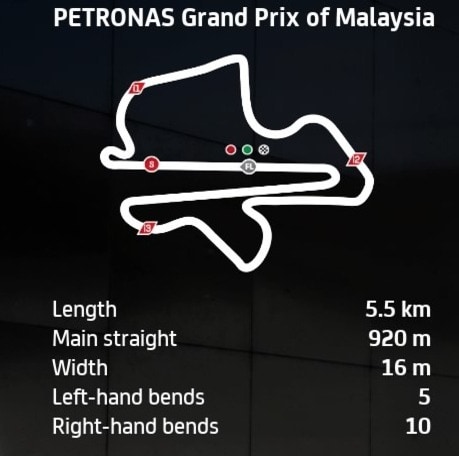The Sepang circuit in Malaysia has become a popular fixture on the MotoGP calendar. Along with tracks like Silverstone and Texas, it’s one of the longer tracks with laps times around the 2 minute mark for MotoGP bikes, with lots of tricky braking zones and cornering sequences you need to get right to put a good lap together.

For a bike setup, you need something that’s well balanced around long sweeping corners, of which there’s many at Malaysia.
And it didn’t take me long to find one, as a slightly altered version of the template setup I usually start with worked very well at this track.
Here’s a MotoGP class bike setup for Sepang on MotoGP 23:
- Suspension (Front Fork):
-
- Front pre-load – 2
- Oil Quantity – 3
- Front Spring Hardness – 4
- Front Swingarm compression – 3
- Front Swingarm extension – 3
-
- Rear Single Shock Absorber:
-
- Rear Pre-load – 4
- Swingarm connector – 3
- Rear spring hardness – 2
- Single shock absorber compression – 3
- Single shock absorber extension – 3
-
- Vehicle Geometry:
-
- Steering head inclination – 4
- Trail – 4
- Steering plate position – 3
- Rear swingarm length – 5
-
- Transmission:
-
- Gears (1-6) – 5-5-5-4-4-4
- Final ratio – 5
- Slipper clutch – 7
-
- Brakes:
-
- Front disc – 355 mm
- Rear disc – 220mm
-
- ECU
-
- Traction control – 5
- Engine braking – 4
- Anti-wheelie – 3
- Power mapping – 2
-
Recommended tyres – Hard front; medium rear
This setup felt felt nicely stable and easy to ride, and has got good stopping power as well for the heavy braking zones. I found it surprisingly easy to lap the Sepang circuit quite consistently using this setup, as I remember hating this track on the last game.
Alternative MotoGP Bike Setup For Sepang
I did also test another setup around Sepang with slightly different parameters:
- Suspension (Front Fork):
-
- Front pre-load – 7
- Oil Quantity – 1
- Front Spring Hardness – 6
- Front Swingarm compression – 1
- Front Swingarm extension – 6
-
- Rear Single Shock Absorber:
-
- Rear Pre-load – 6
- Swingarm connector – 3
- Rear spring hardness – 3
- Single shock absorber compression – 5
- Single shock absorber extension – 5
-
- Vehicle Geometry:
-
- Steering head inclination – 3
- Trail – 4
- Steering plate position – 4
- Rear swingarm length – 5
-
- Transmission:
-
- Gears (1-6) – 5-5-5-4-4-4
- Final ratio – 5
- Slipper clutch – 7
-
- Brakes:
-
- Front disc – 355 mm High Mass
- Rear disc – 220mm
-
- ECU
-
- Traction control – 5
- Engine braking – 4
- Anti-wheelie – 3
- Power mapping – 2
-
This setup also worked reasonably well, and was very strong in sector 1 in particular. But I wasn’t quite as consistent with this one as the first setup, so I’m going with the above setup for now. There isn’t a great deal in it though, so test out both setups to see which you prefer.
Moto2 and Moto3 Setups For Sepang
The less powerful Moto2 and Moto3 bikes are more forgiving in the sense you’ve more time to prepare for corners, and a little more leeway to correct small mistakes. But on a longer track like Sepang, expect super long lap times of 2:10 or longer on these slower bikes.
For setups for these bike classes, check out my generic setup page for MotoGP 23, for starter setups you can bolt on and test against the game default to find improvement in lap time or ease of handling.
Tips For Riding Around Sepang
Sepang isn’t the easiest track to nail for sure, but I’m enjoying it much more on MotoGP 23 than I was on ’22. Here’s some extra tips for riding around there, plus navigating specific corners.
Braking technique – With some heavy braking zones and prolonged corners leading into braking zones, correct braking is crucial. Always err on the side of braking earlier rather than later for heavier stops, and never apply the front brake while leaning the bike (only ever brake when upright). Also, for heavy braking zones, it’s good to take several goes on the front brake rather than applying it once and holding it on.
Turn 1 – Very sharp hairpin, so you need to brake early to get the bike slowed right down to make the corner. Braking point I use is just as the kerbing starts on your left. Take several dabs on the front brake, and then use the rear brake on it’s own to tuck the bike into the corner if needed.
Turn 4 – The 90 degree right hander to finish the first sector. Braking point again is just as the kerbing starts on your left. Can use the rear brake as well to lean the bike in better.
Turns 7/8 – These are the faster right handers. You ride the kerbs on these for faster lap times, but not too much. Just clip them slightly on the inside for a straighter line.
Turn 9 – Super tricky and very sharp uphill left hand corner. Always err on the side of braking early for this corner – even before you reach the Michelin overhead sign. You need to get the bike slowed right down to make this corner. Take several dabs on the front brake, and then you can also use the rear brake to tuck the bike in more.
Turn 15 – Last corner – another heavy braking zone and super easy to over-run. Brake super early for this one as well. For a reference point, I use the overhead Michelin sign which you passed when entering turn 9, which comes into view again on your right as the track comes back on itself on this back straight. Brake just before you draw level with this sign again, applying the front brake several times, and then adding some rear brake on it’s own if needed for a better line to power back onto the pit straight.
Overheating tyres – The front tyre overheats very easily around Sepang on MotoGP 23. Use a hard front tyre to reduce this effect and improve front end grip and stability. Even the hard still gets a little hot with all the prolonged corners, but it’s manageable versus using the medium or soft tyre.
Wet conditions – Rain isn’t uncommon at Sepang, which makes this already challenging track twice as hard. See my guide for riding in the wet on MotoGP games for tips on navigating wet weather conditions.

